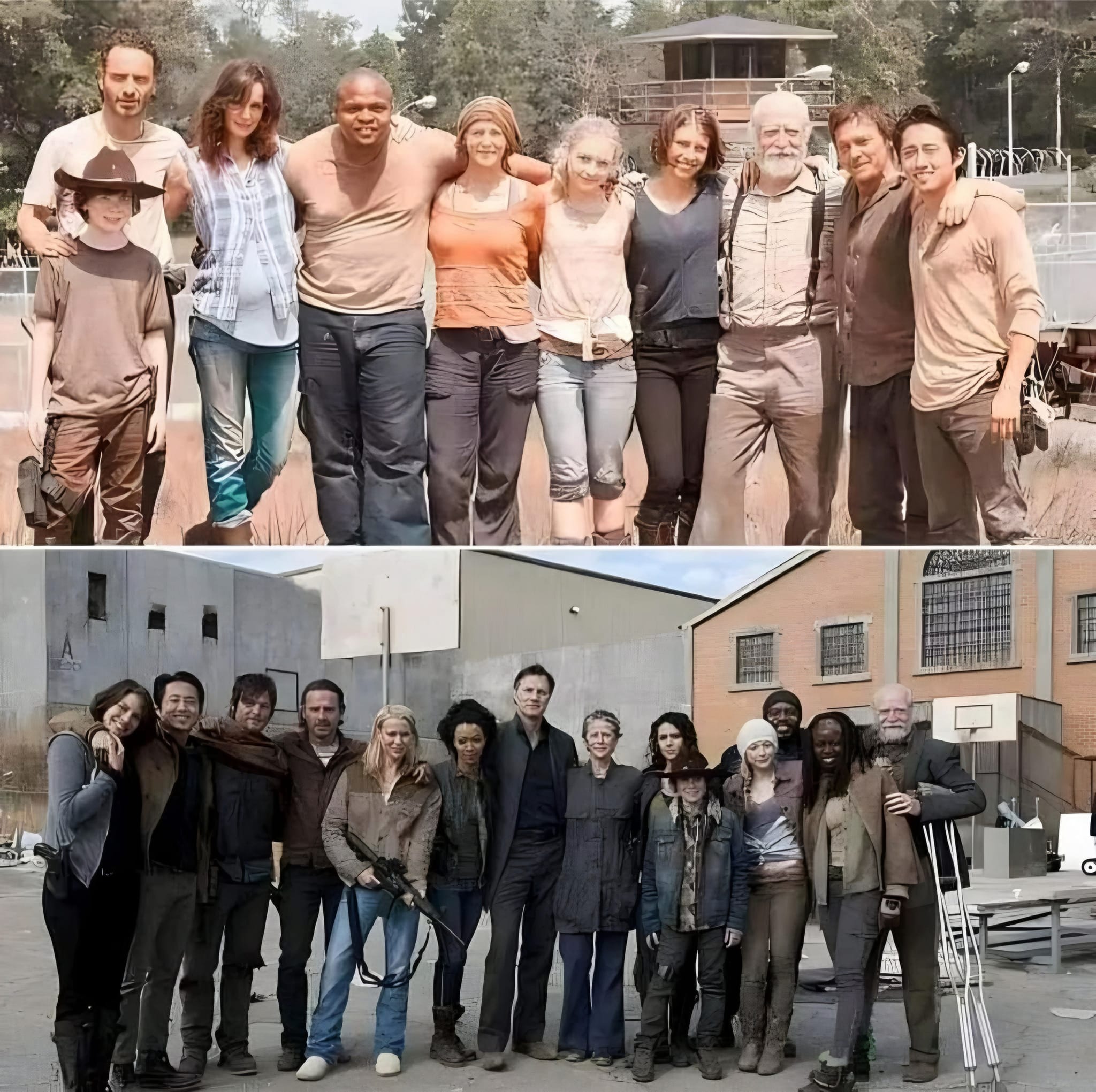The Walking Dead franchise, born from Robert Kirkman’s comic series and brought to life by AMC in 2010, has spanned over a decade, multiple spin-offs, and a sprawling universe of survivors navigating a zombie apocalypse. Among its many settings and storylines, the prison era—primarily encompassing Seasons 3 and the first half of Season 4 (roughly June 2011 to December 2011 in the show’s timeline)—stands out as a fan-favorite, often dubbed the “best time” of the series. This period, set in the West Georgia Correctional Facility, is celebrated for its perfect blend of character development, intense action, compelling antagonists, and a setting that encapsulated the raw essence of survival. But what exactly makes the prison era the pinnacle of The Walking Dead? Let’s dive into the reasons, exploring its narrative, emotional, and cultural impact.

A Sanctuary Forged in Blood
The prison era begins in Season 3, Episode 1 (“Seed”), when Rick Grimes and his group, hardened by a brutal winter on the road after fleeing Hershel’s farm, stumble upon the West Georgia Correctional Facility. Overrun by walkers and partially damaged from a riot during the early days of the Wildfire Virus outbreak in 2010, the prison is a daunting fortress. Yet, its high fences and cell blocks offer the promise of safety—a rare commodity in a world where walkers and hostile humans lurk. The group’s initial assault to clear the prison yard, a tense and thrilling sequence, sets the tone: this is a place worth fighting for. Fans on platforms like Reddit praise this scene as one of the show’s most iconic, showcasing the group’s growing competence and unity.
The prison’s significance lies in its transformation from a walker-infested ruin to a semblance of home. Unlike the temporary refuge of Hershel’s farm or the fleeting safety of the CDC in Season 1, the prison feels like a hard-won sanctuary. The survivors clear cell blocks, plant crops, and even domesticate pigs, signaling a shift from mere survival to building a sustainable community. This sense of ownership—watching “our guys” fight for and shape their home—resonates deeply with viewers, who describe the prison as both “comforting” and “subtly uncomfortable” due to the ever-present threat of danger. The setting itself, with its claustrophobic corridors and open fields, mirrors the dual nature of hope and peril, making it a perfect stage for the drama that unfolds.
Character Development at Its Peak
The prison era shines brightest in its character arcs, which balance personal growth with gut-wrenching loss. Rick Grimes, the group’s leader, evolves from a determined sheriff to a man grappling with trauma. The death of his wife, Lori, during an emergency C-section in Season 3, Episode 4 (“Killer Within”), marks a turning point. Her loss, coupled with the birth of Judith, sends Rick into a spiral of grief, hallucinating Lori’s presence and struggling with leadership. This raw portrayal of PTSD, culminating in Rick’s acceptance of her death by Season 3’s end, is lauded for its emotional depth. Fans note that these moments make the characters feel “like real people,” grounding the apocalyptic stakes in human vulnerability.
Other characters also reach new heights. Glenn and Maggie’s relationship blossoms, evolving from a tentative romance to a partnership tested by capture and torture at the hands of the Governor’s Woodbury faction. Carol, previously a quiet survivor, begins her transformation into a pragmatic badass, learning to prioritize the group’s survival. Daryl Dixon emerges as a reluctant leader, his bond with brother Merle adding layers to his stoic exterior. Michonne, introduced in Season 2 but fully integrated in the prison, becomes a fan favorite, her guarded nature softening through her bond with Carl. Even secondary characters like Hershel Greene, who serves as a moral compass, and the prisoners Axel and Oscar, who integrate into the group, add richness to the ensemble. These arcs, interwoven with themes of trust, loyalty, and sacrifice, create a tapestry of storytelling that fans argue was never matched in later seasons.
The Governor: A Villain Who Changed the Game
No discussion of the prison era is complete without the Governor, the charismatic yet psychotic leader of Woodbury. Introduced in Season 3, played by David Morrissey, he is The Walking Dead’s first true “big bad.” Unlike the walkers, which are a constant but predictable threat, the Governor represents the danger of human ambition. His polished exterior hides a ruthless desire for control, making him a compelling foil to Rick’s group. The conflict between the prison and Woodbury, culminating in the Governor’s attacks on the prison, introduces the show’s first major war between factions, setting a template for future antagonists like Negan and Alpha.
The Governor’s arc peaks in Season 4, Episode 8 (“Too Far Gone”), during the fall of the prison. His brutal execution of Hershel, a beloved mentor figure, shocks viewers and galvanizes the survivors into action. The battle that follows, with tanks, grenades, and hordes of walkers, is a spectacle that marks the era’s dramatic climax. Fans on X describe this period as “peak Walking Dead,” citing the Governor’s blend of charm and cruelty as a key reason the prison arc feels so dynamic. The stakes feel personal—every loss, from T-Dog’s heroic sacrifice to Hershel’s death, hits hard because the characters are fighting not just for survival but for a home they’ve built together.
A Perfect Balance of Zombie and Human Threats
The prison era masterfully balances the dual threats of walkers and humans, a hallmark of The Walking Dead’s early appeal. While later seasons shift toward human-versus-human conflicts, the prison keeps walkers relevant. The group’s initial clearing of the prison, encounters with walkers in the tombs, and the fence’s constant strain under walker pressure remind viewers that the undead are an ever-present danger. A mysterious flu outbreak in Season 4, which turns victims into walkers, adds a new layer of horror, forcing the group to confront death from within. This storyline, though criticized by some for its abrupt resolution after the prison’s fall, underscores the fragility of their sanctuary.
Human threats, meanwhile, add complexity. The discovery of surviving prisoners—Tomas, Axel, Oscar, Big Tiny, and Andrew—introduces tension, as Rick’s group must decide whether to trust them. Tomas’s betrayal and Andrew’s sabotage highlight the risks of integrating outsiders, while Axel and Oscar’s eventual loyalty show the potential for unity. The Governor’s escalating aggression, from kidnapping Glenn and Maggie to orchestrating walker attacks, elevates the human threat to a new level. This interplay—zombies at the gates, traitors within, and a warlord outside—creates a narrative that feels both intimate and epic. Fans argue this era captures the “zombie survival series” vibe better than later seasons, which lean heavily into turf wars.
Cultural Impact and Nostalgia
The prison era coincided with The Walking Dead’s cultural zenith. By Season 3, the show was a ratings juggernaut, attracting the most 18- to 49-year-old viewers of any cable or broadcast series. Its gritty realism, combined with moments of hope, resonated with audiences, making the prison a defining symbol of the fandom. The location is so iconic that it’s featured in Universal Studios’ Walking Dead attractions. Social media posts reflect this nostalgia, with users like @katieshox calling the prison arc “THE era” for its set, drama, and storytelling.
The era’s smaller cast and focus on the original characters also contribute to its “cozy” feel, as fans put it. Unlike later seasons, which introduce sprawling communities and action-hero dynamics, the prison feels intimate. The group’s struggles—clearing cell blocks, mourning losses, planting seeds—ground the story in relatable human experiences. This balance of raw survival and emotional stakes makes the prison era a touchstone for fans, who often cite it as the moment the show “found its groove.”
Flaws and Legacy
The prison era isn’t without flaws. Some criticize the flu storyline for its inconsistencies and the prison’s questionable defenses, like the chain-link fence that walkers repeatedly strain. Others note that the group’s failure to fully clear the tombs left them vulnerable, a complacency that cost lives. Yet, these imperfections add to the realism—survivors aren’t architects or military strategists, and their mistakes reflect the chaos of the apocalypse.
The fall of the prison, while devastating, cements its legacy. The battle in Season 4 scatters the group, forcing them to confront new challenges on the road and at Terminus. This loss reinforces the show’s recurring theme: no sanctuary is permanent. Yet, the prison’s impact endures. It’s where Rick becomes a leader, Michonne finds a family, and the group learns that survival requires both strength and compassion. The era’s influence is evident in later settings like Alexandria, which build on the prison’s lessons of community and defense.
Why It’s the Best
The prison era is The Walking Dead at its finest because it captures the essence of the zombie apocalypse: a fight for survival against impossible odds, tempered by hope and humanity. Its setting, a fortress both protective and precarious, mirrors the survivors’ resilience. The characters’ growth, from Rick’s grief to Carol’s grit, grounds the story in emotional truth. The Governor’s menace and the walkers’ relentless threat create a narrative that’s thrilling yet intimate. For fans, the prison isn’t just a place—it’s a symbol of the show’s golden age, a time when every episode felt like a battle for home. That’s why everyone’s still talking about it.





